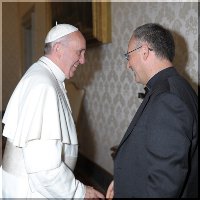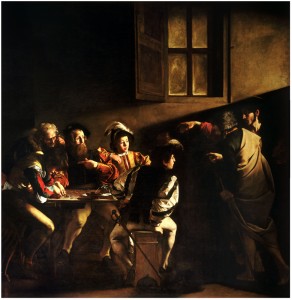Special Blog by Father Jonathan: Holy Mary….Pray for Us Sinners….
Posted by SociusSep 25
“Holy Mary, mother of God, pray for us sinners now, and at the hour of our death, Amen”.
I wonder what we make of our acknowledgement of the word ‘sinner’. ‘Pray for us sinners’ implies that all who say that prayer is a sinner. So you, dear reader, do you like to consider yourself to be a sinner? I have been in the company of very good Christians who think that the new translation of the Mass goes on too heavily about being a sinner.
In the new ‘I confess’ at the beginning of Mass the text includes:
”I confess to almighty God ….. that I have greatly sinned,……in my thoughts and in my words, …….through my fault, through my fault, through my most grievous fault.”
My good Catholic friends find the tone of this is far too serious for them, especially the words ‘my most grievous fault!’ These friends, whom I respect highly, also dislike the formula we say before Holy Communion as being in the same ‘too heavy’ direction: ‘Lord, I am not worthy that you should enter under my roof, but only say the word and my soul shall be healed.’ Personally, neither phrase offends me, because I do realise that I am a sinner, and sometimes in my view, I have not been a mild one. However, God alone knows the seriousness of any sin.
Recently, in August this year, Pope Francis had a public conversation for the World-wide Jesuit Religious Order, of which he is a member, and the text was only released last week, after the strictest security: the Vatican Officials had not known about it until the conversation was published.
 |
Pope Francis with Fr. Antonio Spadaro SJ
A Big Heart Open to God: The exclusive interview with Pope Francis – August 2013
Editor’s Note:
This interview with Pope Francis took place over the course of three meetings during August 2013 in Rome. The interview was conducted in person by Antonio Spadaro, S.J., editor in chief of La Civiltà Cattolica, the Italian Jesuit journal. Father Spadaro conducted the interview on behalf of La Civiltà Cattolica, Thinking Faith, America and several other major Jesuit journals around the world. The editorial teams at each of the journals prepared questions and sent them to Father Spadaro, who then consolidated and organised them. The interview was conducted in Italian. After the Italian text was officially approved, a team of five independent experts were commissioned to produce the English translation.
The setting is simple, austere. The workspace occupied by the desk is small. I am impressed not only by the simplicity of the furniture, but also by the objects in the room. There are only a few. These include an icon of St. Francis, a statue of Our Lady of Luján, patron saint of Argentina, a crucifix and a statue of St. Joseph sleeping. The spirituality of Jorge Mario Bergoglio is not made of “harmonised energies,” as he would call them, but of human faces: Christ, St. Francis, St. Joseph and Mary.
The pope speaks of his trip to Brazil. He considers it a true grace, that World Youth Day was for him a “mystery.” He says that he is not used to talking to so many people: “I can look at individual persons, one at a time, to come into contact in a personal way with the person I have before me. I am not used to the masses,” the pope remarks. He also speaks about the moment during the conclave when he began to realise that he might be elected pope. At lunch on Wednesday, March 13, he felt a deep and inexplicable inner peace and comfort come over him, he said, along with a great darkness. And those feelings accompanied him until his election later that day.
The pope had spoken earlier about his great difficulty in giving interviews. He said that he prefers to think rather than provide answers on the spot in interviews. In this interview the pope interrupted what he was saying in response to a question several times, in order to add something to an earlier response. Talking with Pope Francis is a kind of volcanic flow of ideas that are bound up with each other. Even taking notes gives me an uncomfortable feeling, as if I were trying to suppress a surging spring of dialogue.
The first question and answer was as follows:
Who Is Jorge Mario Bergoglio?
I ask Pope Francis point-blank: “Who is Jorge Mario Bergoglio?” He stares at me in silence. I ask him if I may ask him this question. He nods and replies: “I do not know what might be the most fitting description…. I am a sinner. This is the most accurate definition. It is not a figure of speech, a literary genre. I am a sinner.”
The pope continues to reflect and concentrate, as if he did not expect this question, as if he were forced to reflect further. “Yes, perhaps I can say that I am a bit astute, that I can adapt to circumstances, but it is also true that I am a bit naïve. Yes, but the best summary, the one that comes more from the inside and I feel most true is this: I am a sinner whom the Lord has looked upon.” And he repeats: “I am one who is looked upon by the Lord. I always felt my motto, Miserando atque Eligendo [By Having Mercy and by Choosing Him], was very true for me.”
The motto is taken from the Homilies of Bede the Venerable, who writes in his comments on the Gospel story of the calling of Matthew: “Jesus saw a publican, and since he looked at him with feelings of love and chose him, he said to him, ‘Follow me.’” The pope adds: “I think the Latin gerund miserando is impossible to translate in both Italian and Spanish. I like to translate it with another gerund that does not exist: misericordiando [“mercy-ing”].
 |
The calling of St. Matthew by Caravaggio 1599-1600
Pope Francis continues his reflection and says, jumping to another topic: “I do not know Rome well. I know a few things. These include the Basilica of St. Mary Major; I always used to go there. I know St. Mary Major, St. Peter’s…but when I had to come to Rome, I always stayed in [the neighbourhood of] Via della Scrofa. From there I often visited the Church of St. Louis of France, and I went there to contemplate the painting of ‘The Calling of St. Matthew,’ by Caravaggio.
“That finger of Jesus, pointing at Matthew. That’s me. I feel like him. Like Matthew.” Here the pope becomes determined, as if he had finally found the image he was looking for: “It is the gesture of Matthew that strikes me: he holds on to his money as if to say, ‘No, not me! No, this money is mine.’ Here, this is me, a sinner on whom the Lord has turned his gaze. And this is what I said when they asked me if I would accept my election as pontiff.” Then the pope whispers in Latin: “I am a sinner, but I trust in the infinite mercy and patience of our Lord Jesus Christ, and I accept in a spirit of penance.”
=====================================
Perhaps Pope Francis will throw light onto the meaning of the second half of the Hail Mary for some of us….. And if you are interested in reading the rest of the interview (which is fascinating and long) you will find it on our St. Mary’s website under the Bulletin tab and then scroll to the first option, bulletin home. There are many headings and you might like to read one topic only and then return to the whole talk later.
Father Jonathan

No comments